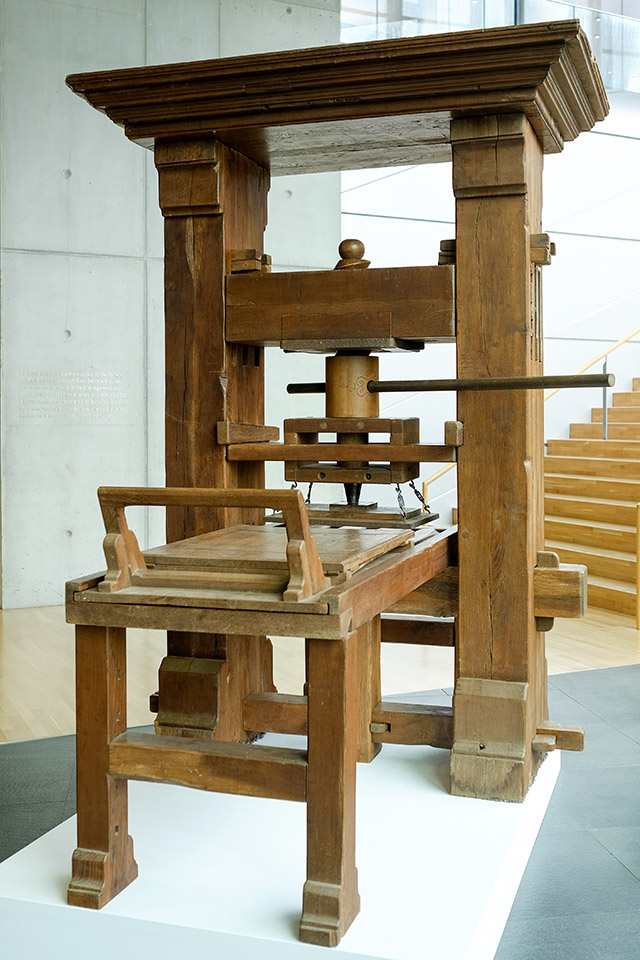Cultural history collection
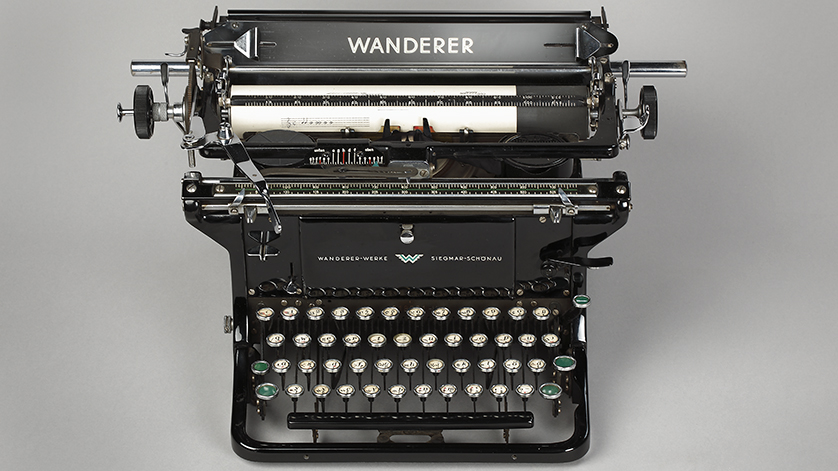 Photo: Klaus D. Sonntag
Photo: Klaus D. Sonntag
Books, archival materials and picture sources alone are not enough to impart a sound knowledge of the history of books, writing and paper. Other collectables – particularly machinery and tools – provide comprehensive information on how the materials, manufacturing equipment and technological processes used in production have changed over time. Whether sieves, typesetting machines or writing utensils: the Museum’s extensive cultural history collection offers fascinating insights into the cultural techniques of writing and printing. However, the cultural history collection, which consists of around 9,000 artefacts, also contains testimonies to the early days of books and writing from cultures around the world.
History of the collection
The foundations of the present-day collection are the remainders of the former technical collections and the so-called exhibition collection (Schausammlung), which was recovered from a book dealership destroyed by British aerial bombardment in 1943. Some of the artefacts still show traces of gunshot even today.
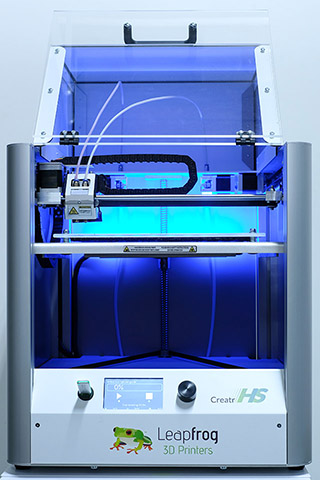 3D printer, Creatr HS manufactured by Leapfrog 3D Printers, 2016, fused deposition modelling (FDM) printer in functional condition
3D printer, Creatr HS manufactured by Leapfrog 3D Printers, 2016, fused deposition modelling (FDM) printer in functional condition
Since 1955, the Museum has been systematically expanding its collection by means of donations and new acquisitions. The collection was significantly enhanced in 1964, when the German Paper Museum in Greiz was integrated into the German Museum of Books and Writing. Since 1990, the Museum has acquired important artefacts relating in particular to the polygraphic techniques on which the most important technical developments were based; these include sieves, printing machines, polygraphic devices, prototypes of commercial book machines and accessories. Some of these relics of past times have found their way into the Museum's current exhibitions.
The collection is not subject to any chronological, regional or temporal restrictions. However, we deliberately choose materials, tools, machinery and artefacts that represent significant technical and cultural developments both historically and in the present day. This means that greater importance is attached to exemplary character than to completeness. Our collection activities also extend to present-day developments and encompass new digital recording, storage and reproduction techniques, e.g. computers, scanners and 3D printers.
Holdings
Numerous original testimonies to the history of books, writing and paper bear witness to their times.
We attempt to document the environment in which the object developed by collecting additional archival materials such as operating instructions, company brochures and pictures of everyday working life. The originals, reproductions and models in the cultural history collection are also reference objects and complements to the Museum’s other collections. The collection encompasses:
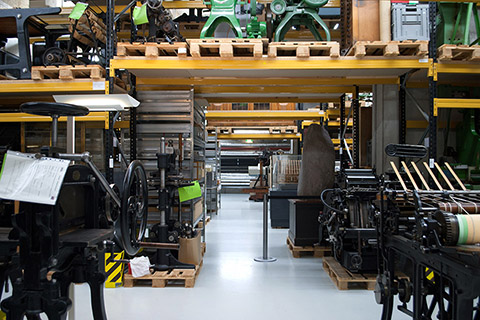 A look inside the stacks of the cultural history collection
Photo: Marie Tollkühn
A look inside the stacks of the cultural history collection
Photo: Marie Tollkühn
- Predecessors of the book: steles, clay tablets, papyrus
- Writing materials and utensils: styluses and slates, inkwells, fountain pens, typewriters
- Monuments and cult objects from the history of writing and script: obelisk of Assyrian king Shalmaneser III, the Rosetta Stone
- Tools and materials used for original graphical techniques and reproductions: lead typefaces, wooden typefaces, tools and equipment used by punch cutters, typesetters, lithographers and music engravers
- Tools and machinery used for manufacturing printing plates and printing: typesetting and casting machines, jobbing and cylinder presses
- Tools and machinery used to manufacture, inspect and process paper: model of a paper mill, sieves, dandy rolls, folders, tearing testers, paper scales
- Bookbinding tools and materials: design used on handmade binding, gilding tools, sewing frame, staplers and paper cutters
- Book art, book sculptures, paper art
Special exhibits from Korea and China
Johannes Gutenberg’s invention of the printing press with movable letters in the mid-15th century ushered in a whole new era of media. However, in Korea, a book was printed using movable letters as early as 1377.
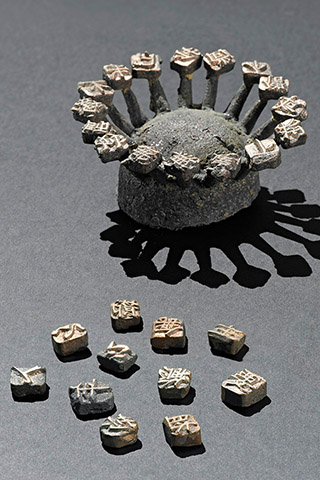 Korean letterpress printing, finished letter tree with branches and 16 letters, Korea, 1377. Reproduction
Photo: Bertram Kober/PUNCTUM
Korean letterpress printing, finished letter tree with branches and 16 letters, Korea, 1377. Reproduction
Photo: Bertram Kober/PUNCTUM
The cultural history collection contains an object that testifies to the early Chinese experiments with movable clay print stamps allegedly made by smith Bi Sheng in around 1040. This is a reproduction of the original iron jig in which individual clay stamps with word symbols were arranged into a block of text and fixed with resin before stamping.
Thanks to a generous gift from the Early Printing Museum in Cheongju, South Korea, we are able to show guests to our museum the early Korean printing methods that have been documented since 1377. Various raw materials for manufacturing matrices and around 450 faithful reproductions of die casts, letter branches and metal letters through to the mounted print form show the individual steps involved in manufacturing letters using wax and sand casting processes.
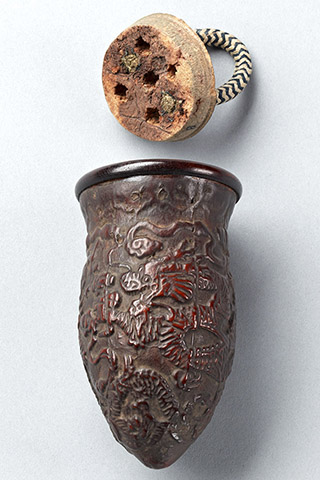 Cricket cage from a Chinese scholar’s house, China, c. 1900
Photo: Bertram Kober/PUNCTUM
Cricket cage from a Chinese scholar’s house, China, c. 1900
Photo: Bertram Kober/PUNCTUM
Along with additional image and film material on manufacturing letters, the donation also includes a facsimile of the famous “Jikji Simche Yojeol” (Collected Teachings of Zen Buddhism). This book is the oldest known testimony to the use of movable metal letters (made of copper) in Korea. It was printed in 1377 at the Heungdeok temple in Cheongju using Chinese script. In contrast to European book printing techniques using mechanical printing presses, early printing processes in the Far East involved stamping or rubbing using wooden boards or by hand. The Early Printing Museum was established in 1992 in Cheongju, where the “Jikji” were found, as a form of tribute to early printing in Korea.
A selection of Korean printing materials from the generous donation by the Early Printing Museum in Cheongju is on display in our permanent exhibition, where they are contrasted with the materials used for Gutenberg's printing technique.
Gallery of images from the cultural history collection
Contact: Wolfgang Hohensee
Last changes:
01.11.2021


